Seen in Munich...
 Monday, January 7, 2013 at 5:11
Monday, January 7, 2013 at 5:11  Frau A ...
Frau A ...  Post a Comment
Post a Comment  Monday, January 7, 2013 at 5:11
Monday, January 7, 2013 at 5:11  Frau A ...
Frau A ...  Post a Comment
Post a Comment  Thursday, October 18, 2012 at 21:15
Thursday, October 18, 2012 at 21:15 It took a year (during which I spent most of that time working too much and planning a wedding instead of sewing), but I finally finished the dirndl I started!
Probably a pretty crazy idea since I didn't have much sewing experience, but I'm so glad I did it. I learned a lot about sewing, many new German terms, and I learned a lot about trachten. I look at dirndls in a totally different way now, having sewn one. And I have a lot of respect for how well-constructed my wedding dirndl is!
Oh, and I'm pretty sure I now know then entire inventory of both the Oberpollinger and Karstadt am Bahnhof sewing departments.
I started last year with a dream, a pattern, and a pile of fabric. (Burda #7443, for anyone who wants to try)
This was the original plan...which of course NEVER quite is reality. I'll be honest, I struggled with the apron fabric. I wanted to sew the dirndl in silk instead of cotton, and it was tough then finding suitable apron fabric. I'd decided to go with this striped orange and green stuff, which would pick up the purple as well.

The first mishap was the lining (the lighter purple fabric), which apparently I cut out backwards. That was easily remedied, and with new lining (which I liked better), I completed the bodice. Even assuming you make no mistakes, you have to cut and mark all 14 pieces three different times (outer fabric, lining, and interfacing). Painful!! That definitely was the worst part.
I also learned an important lesson about not deviating from the pattern. I was a little worried it would be too tight, so I sewed them together with less seam allowance than indicated. Which would have been fine, except that in the end it was a little too big. Taking in the seams normally would be no problem, but it was a bit trickier with trying to make the same alterations to the lining and have everything still fit together!
But the bodice turned out well and the skirt perfectly. And then it sat for months.... at first I was a bit afraid to finish it since I'd gained some extra weight. But then after a successful workout regimen that was no longer an excuse. I had to just face the fact that I was scared to sew the two pieces together!
Due to my bodice adjustments, the seams didn't all line up perfectly, but I'm still pleased with the results of my first effort. Here are the front and back views.


As soon as I stopped congratulating myself that the dress was not a total disaster, I quickly learned the ugly truth that the real work was still ahead of me. It took a couple weeks of scouring the internet (English and German) to find out how to make the lovely dirndl trim. The biggest difficulty was not knowing what you call the stuff. (It's called box-pleated trim in at least one version).
But then when I showed Herr J the plan, he correctly pointed out that the apron really didn't go well with the dirndl. And ....back to the drawing board....
After a few more outings to the fabric store, I settled on this purple floral brocade. Sometimes procrastination pays off. As in when I first moved to Germany, there was no drivers' license reciprocity with Texas. And when I finally got around to applying for my German license 3 1/2 years later, they'd signed a treaty and all I needed was a vision test. This time, one fabric store stocked a very limited range of pre-made trim. It was quite new and even the fabric store ladies had no idea what it was called, thus reassuring me that it wasn't just my stupidity in not knowing what to call this stuff.

Unfortunately, the trim didn't work out either. I guess I was forcing it, trying to make something match from a very limited number of trims.
At this point I took a very patient Herr J to the fabric store and got his help. After about an hour of trying different things, I settled on a flat braided silver trim that he suggested. And then bought the necessary trimmings and silver thread.

The silver metallic thread was a dream - not as easy to sew with as regular thread, but it blended in perfectly and you can't see where the trim is attached. The final step of sewing on the buttons was a bit scary, since any mistakes would be clearly visible. But, I needed to finish it up before Oktoberfest and had to take the plunge.
I can't count how many trips I made to various stores to buy more of something, or something different. Or tried to ask for something in a store, only to realize that I have no idea what it's called in English, let alone in German. Even though my apron pattern called for pencil pleating tape and the German instructions called it "stiftelband," twice the store staff didn't know what it was. They did refer me to a specialty sewing store...that was of course closed for holidays for the month of August. I stumbled across it in a department store when buying ribbon for the wedding favors.

So finally, after a long adventure, I did finish the dirndl. I'd love to make another one, but have more dirndls that I should have already. The table of trachten fabric does call to me when I pass it in the store. But for now I'm going to concentrate on other projects. Possibly even more crazy than making a dirndl with very little sewing experience...

 Wednesday, April 4, 2012 at 9:00
Wednesday, April 4, 2012 at 9:00 Winter is ending, festivals are beginning...which means it's time for more trachten! I got to wear mine this weekend for a bachelorette party. Yes, somehow trachten has become typical bachelor(ette) party wear.
For some fun, here are celebrities in trachten.
Hippodrome has its own web pages to document (mostly German) celebrities that were in the tent. Other sites have dedicated pages to famous ladies in a dirndl.
It wouldn't be a "celebrity" post without at least one Kardashian and one Hilton....
And then popular institution Wetten Dass... seems to often have beautiful foreign women on the show in dirndls. First, Katy Perry...
...and Salma Hayek (with Karl Lagerfeld).
The pages of the celebrity magazines here will often have some of FC Bayern's stars in trachten. Here we have Bastian Schweinsteiger and Thomas Mueller with their partners.
And the ladies' favorite, Mario Gomez at Paulaner Nockherberg
At Oktoberfest last year, Boris Becker opted for trachten on top and jeans on the bottom, while his wife Lilly chose a beautiful dirndl with flowers in bodice. (For those of you not living in Germany, Boris Becker is not just a tennis star from 20 years ago...he's a constant presence in the tabloids and society pages)
Only at the Hofbräuhaus in Vegas do they have Hugh Hefner's girlfriends tapping the keg... Not exactly the authentic type of dirndl, but hey, it is Vegas!
And of course Heidi Klum's Got Milk ad

 Monday, October 17, 2011 at 9:00
Monday, October 17, 2011 at 9:00 A decado ago, only real locals and diehards wore traditional dress.
Nowdays, trachten is chic and you'll see many young people wearing it - not only at Oktoberfest, but to beergartens, summer festivals, bachelor(ette) parties (polterabend), and FC Bayern games (lederhosen bottoms, no suspenders, and an FC Bayern jersey are the outfit for the cool Bavarian guys).
Even Ken and Barbie are in on the trend!
Vogue Germany ran a ten-page trachten special promotion spread by Munich department store Loden Frey in its magazine, covering more than just the normal dirndl and lederhosen wear (Frau A wants those boots and the red jacket!). 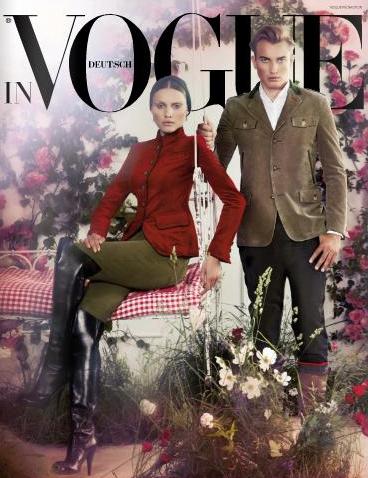
And if a good classic pair of deer-skin lederhosen aren't quite enough for you, there are some designer alternatives...Hugo Boss has lederhosen for the modern brand-conscious man.
"Only" 399 euros for the shorts and 499 euros for the dirndl...Of course you'll also need the shoes, which run almost the same price as the trachten.
Even Tommy Hilfiger has lederhosen, albeit for children.
For the more sporty, but still fashion-conscious man, Adidas offers Bayern Munich lederhosen!
But it doesn't end with lederhosen and dirndls...These days there are trachten accessories - either to personalize your trachten, or to wear as a little bit of kitchy Bavarian fun (instead of the full costume).
Here are some typical acessories, which now also come in fashion versions for big prices. We'll cover trachten trends in a separate post, but in addition to the standard 3 piece dirndl (dress, blouse, apron), dirndl shoes, dirndl purses, and dirndl jewelry are almost obligatory. That's even before we get into the super trendy hats, stockings, sweaters, and hairstyles! (these beer mug ballerina flats are cute, but are going to cost you 170 euro! Frau A is thinking "craft project")
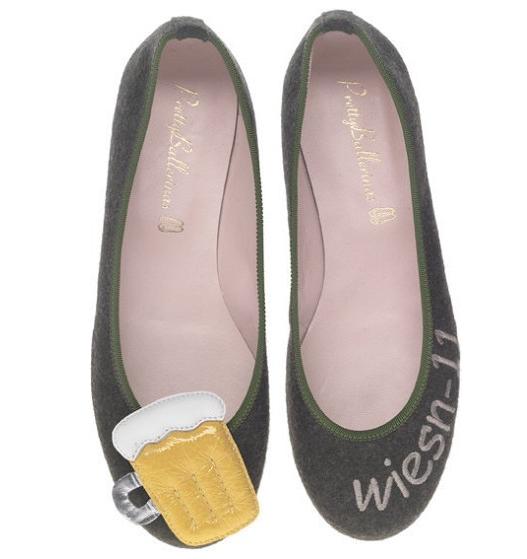
And what if you want to add some trachten to your casual style? well, luckily there are bathing suits!
Finally, Austrian store Tu Felix Austria takes trachten-inspired casualwear to a new level, with men's underwear and sports lines (and funny, obviously photoshopped photos of models in the Alps).
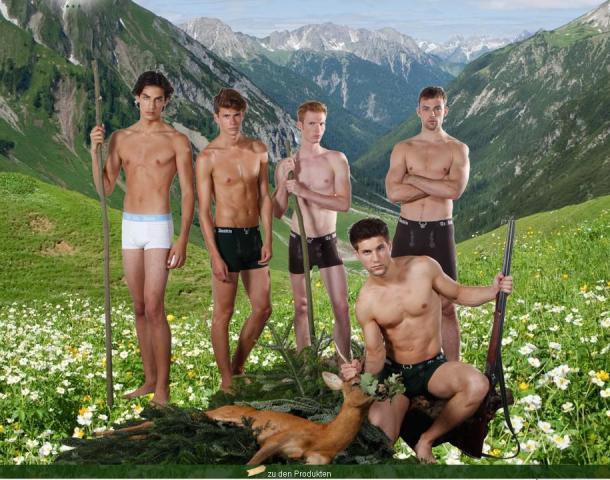
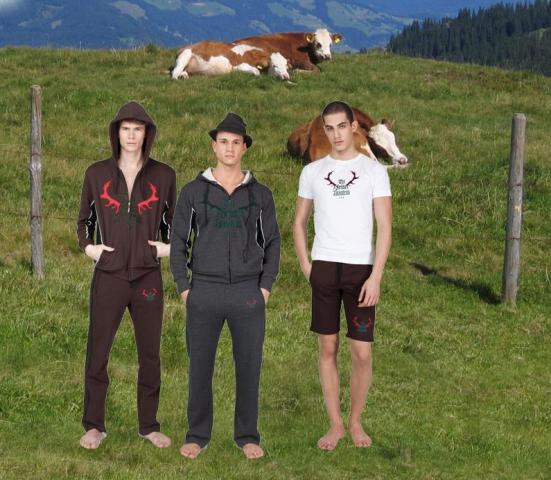
And some pretty cute onesies to start the little ones off on the right foot!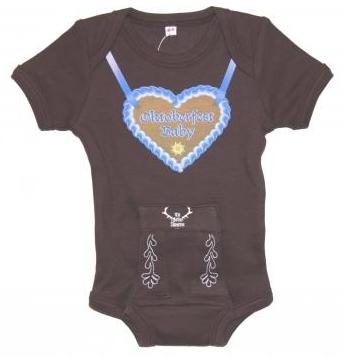
 Tuesday, September 20, 2011 at 8:00
Tuesday, September 20, 2011 at 8:00 Oktoberfest opens with a Saturday parade - the breweries march to the Wiesn and the mayor taps the first keg.
The next day, Sunday, has a longer parade that focuses on the traditional dress/costumes (trachten).
The marchers came from all over Bavaria & Germany, plus Austria, Switzerland, Italy, and even Hungary!
This blog post won't go in parade order, like the Saturday parade, but will be organized by topic:
- Couples and Flower Arches
- Ladies and Gentlemen
- Children
- Hunting, Horses, and Marching Bands
- Commercial and non-trachten participants
Introduction
Each of the 60 marching groups (!) was preceeded by a number marker -- a program was sold with information about each segment: where they're from, how old the local/regional costume is, and other interesting details.
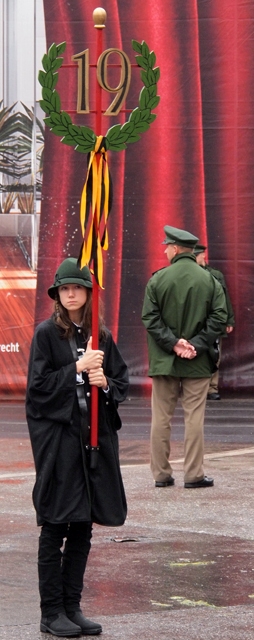
(Note: the entire parade included 8500 participants and took almost 3 hours to run!
I tried to document here as much as possible about where the people and outfits come from...)
Many towns or regions brought their own banner or standard to lead their part of the procession.
For example, the town of Lindhorst is in Niedersachsen (state of Lower Saxony) in northern Germany:
Another example: 16th century / medieval outfits from Upper Bavaria:
Freising is a town near the Munich airport, and home to a colleague of mine - quite a standard to bear too:
Another example were the memorable blue & white uniforms from the town of Eschwege in Hessen:
Some marchers also carried flags and performed tosses (these from Konstanz, near the Swiss border):
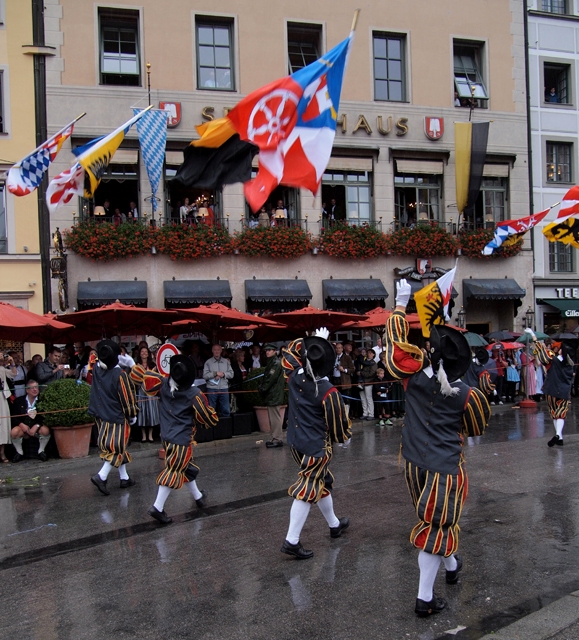
This lady from the Hacker-Pschorr brewery was great: she pulled up her dirndl for a peek at her garter.
Look at the expression on the Asian couple's faces on the left side - makes a memorable Oktoberfest...
The jesters added some moves to their walk through Munich:
In addition to costumes and marching bands, there was more traditional music -
here two Swiss men stopped to play the Alpine horns!
They are from Auenstein, in the north-west of Switzerland. And here is the video!
Couples (plus Flower Arches)
Here are some typical trachten outfits (mostly not lederhosen, and less cleavage than Oktoberfest today):
Finally -- the first nice German beard:
The traditional costumes ranged from the conservative, almost colonial...
... to slightly more frilly with some interesting accessories (his hat, and in his left hand?)...
(The funky hats are local - Munich - but the design inherited from a region in Romania. Interesting!)
... to even more interesting accessories -- the next photo has a substantial hat/head ornament...
(outfits are from the Franconia area of Germany which includes Northern Bavaria & part of Thuringa)
...to some that have a strong eastern European flavor. (Again, representatives from Lower Saxony.)
One interesting aspect was the prevalence of plant and flower arches, in all sizes and colors.
I don't know the meaning or significance of these, but they were quite lovely.
Some were carried along by themselves:
A group from the state of Hessen brought bright arches, with their wide red "ascots" dating to 1900:
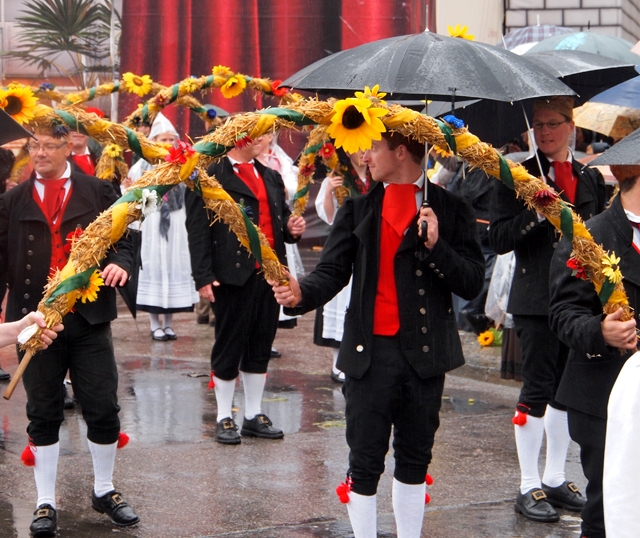
Other flowers were carried by men, with a woman under the arch...
(strangely, these marchers from from a sports association outside Regensburg, Bavaria):
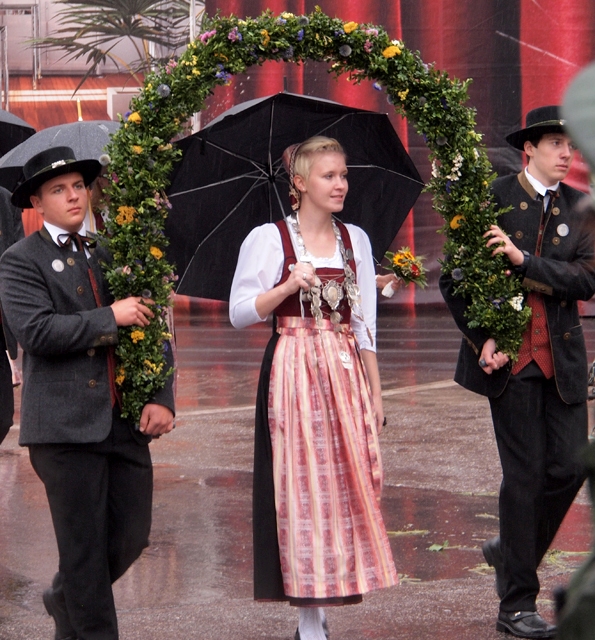
...others were carried by women with a man under the arch...
(notice how the men are "decorated" - indications of authority... könig means "king")

...still others were carried by men with a man in the middle. Again, I don't know why.
According to the program, almost all of these photos are of people from local sports associations.
Maybe it's some of their local individual or team champions??? Any readers know?
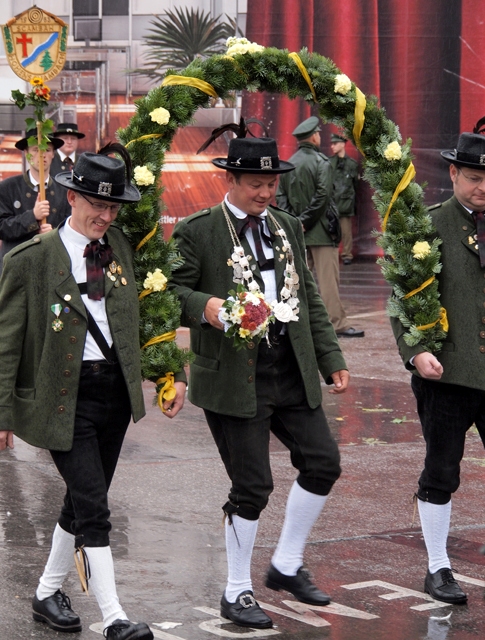
Some flowers were colorful and large -- must have taken a long time to prepare everything:
One in particular was more complex, with something like a crown on top:
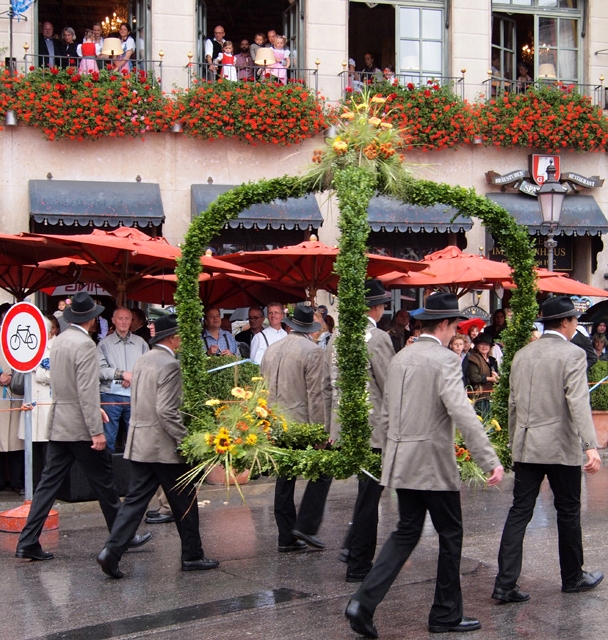
Maybe the prior photo was similar to a maypole, which was also present in the parade (below)?
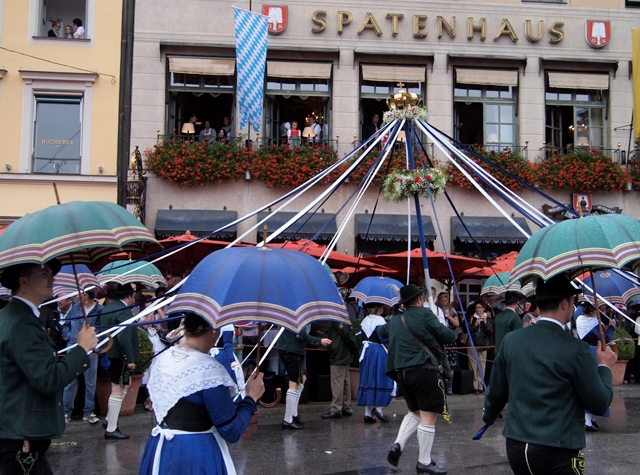
If you look closely, you can sometimes see town seals or crests that show where they're from:
Here is a video showing what the flower arches looked like en masse, as they went by:
The flower arches were one of the nicest parts of the parade:
Ladies and Gentlemen
Again, some outfits were quite soft and subdued. Below is more 16th century / medieval dress from Bavaria.
(Naturally, these remind me of a Renaissance fair or Robin Hood.)
The ladies almost always carried flowers:
The costume below comes from upper Bavaria (men in background have lederhosen, of course).
These are classic dirndls, hats, and suits for the guys - would look fantastic in an Oktoberfest tent:
Notice the hops on her hat (below) and her carrying two silver bells - the program states that the silver chain (and probably bells too) are traditional in that Bavarian town, but doesn't explain why/any meaning behind them:
The weather was terrible - cold and rainy. Umberllas in the crowd and over the participants:
These were the ladies from Zala, Hungary! Folk costumes (cattle herding) are from the late 14th century:
Again, we saw some fascinating hats. First one (below) is made of otter fur.
These are fishermen's/women's attire from Starnberg, outside of Munich.
The hats below from the Black Forest region, in the German state of Baden-Württemberg:
And the eastern European influence shows up yet again in traditional costumes from Lower Saxony:
Other accessories ranged from traditional purses (and "eagle's feather" in the hat)...
...to full baskets...
...to old fashioned Franconian vegetable/harvest baskets strapped over the back...
...to horns with flowers (the first of the three photos is a woman from Bruneck, Italy!)...
Other flowered horns come from Bavaria (next photo, below):
The third lady with a horn + flowers comes from Percha, Italy:
The best: tiny beer kegs / wine barrels!!! The guys in these towns are lucky, unless the ladies don't share.
The first example comes from Chiemsee, outside of Munich. Coins are just ornamental, no significance:
The last one is a traditional costume from Ebersberg (Bavaria) from around 1800:
As for the men, some costumes were just dapper (below from Dachau, outside Munich)...
...but many had a military-like background (below is Munich's city police corps, uniforms from 1813):
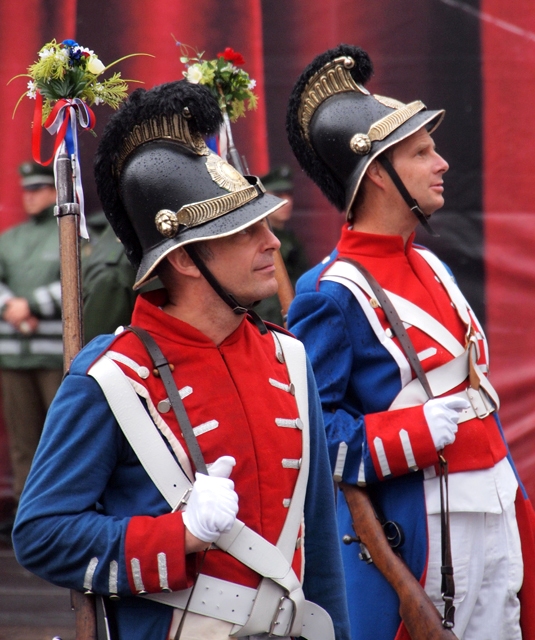
Next is a military uniform from Baden-Württemberg from the mid-1800s:
Their accesories were swords as well as guns (below from Tegernsee, Bavaria, not far from Munich):
Uniforms of others had a feel of command or authority (commander, mayor, etc.).
The man below was marching with a band from Königsdorf, another Upper Bavarian town.
The next man represents Vigo di Fassa, Italy. It's in the Dolomite Mountains, so culturally similar...
I can't explain this accessory, but read that it comes from the Augustiner brewery in Munich.
His uniform (below) is from Augustiner's Oktoberfest band.
Here we have guns, an wood antler-like rake, an axe, and spear. The marchers' outfits commemorate the peasants' uprising of 1705 during the "Bloody Christmas" in Sendling, Bavaria.
The traditional dress (photos above & below) are from Bavaria and date to 1800.
The lederhosen and well-groomed moustache should give the origins away!
And this flag bearer also carried a mace!!! (Flag is covered with plastic due to the rain.)
This last male accessory was a large pair of cowbells that this guy would swing back & forth:
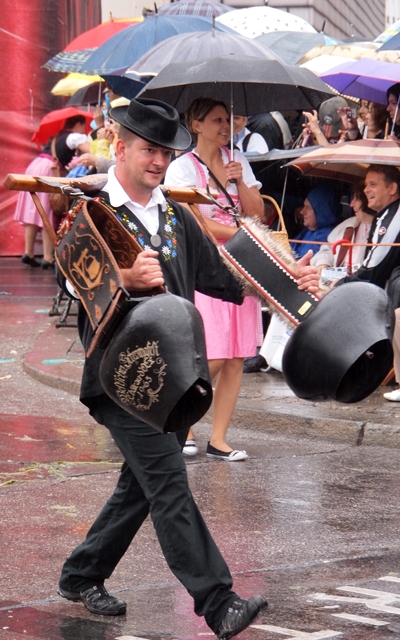
He was part of the group from Switzerland, where men played the very long Alpine horns.
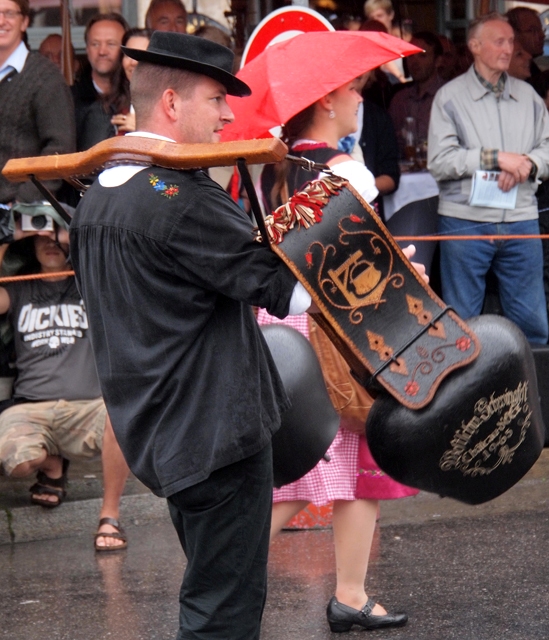
Children
The cutest part of the procession. The next two girls come from Baden-Württemberg.
The ornamentation on these outfits is "according to family status".
...but not always happy with the rain puddles all along the route:
These were almost toy soldier uniforms... and this boy has a big teddy bear!!! The uniforms are from the Hacker-Pschorr band, inherited from the Crown Prince Second Infantry Regiment (1805), Bavaria.
Love the colors on her below -- she's from a Polish youth organization in Munich:
Nice outfit from Konstanz (near the Swiss border), and he got to be a flag bearer:
Finally, a tiny princess in her wagon, from nearby Markt Schwaben in Munich. Cute overload.
Hunting, Horses, and Marching Bands
Hunting was a common theme of the marching groups as well. They brought their dogs, AWESOME.
Photos (and the video) below are from the Hunting Association of Bavaria:
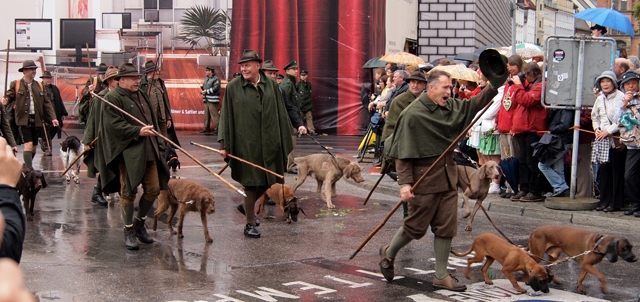
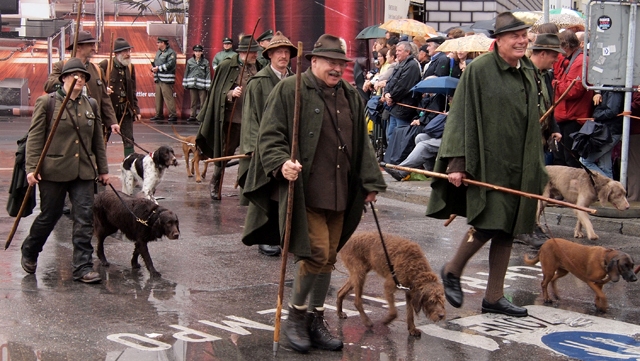
Check out the video -- they brought a falcon as well. This was really cool:
This was interesting -- a princess of hunting and texidermy? She would do well in Texas.
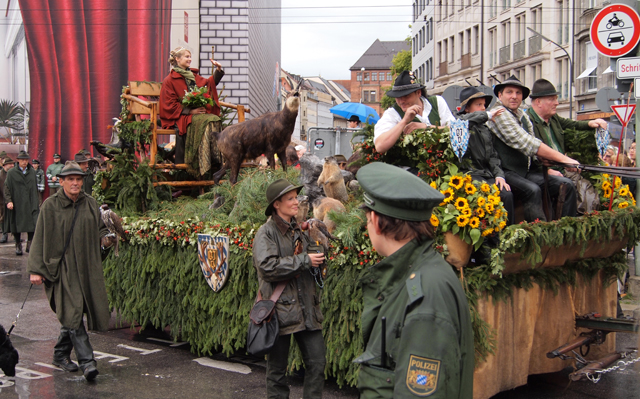
Look at all the taxidermied animals! (And there is the hunting falcon again, lower right.)
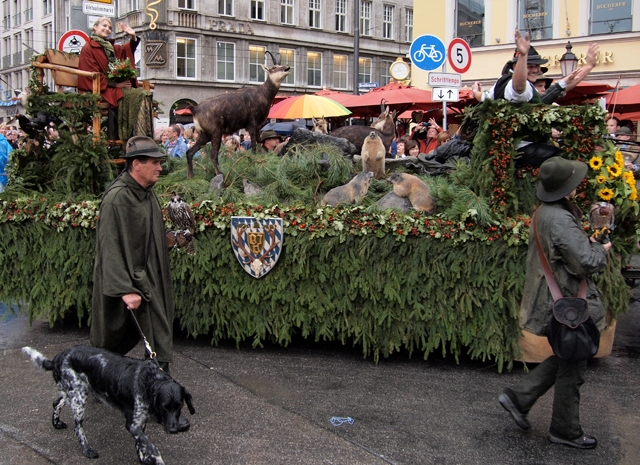
I don't know the story behind this one, but it must be pretty good. Not your usual parade wagon:
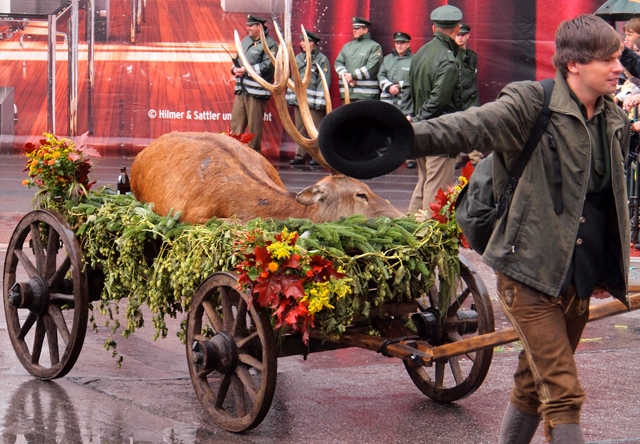
The hunters had colorful outfits as well, including rifles (again, medieval dress from Bavaria)...
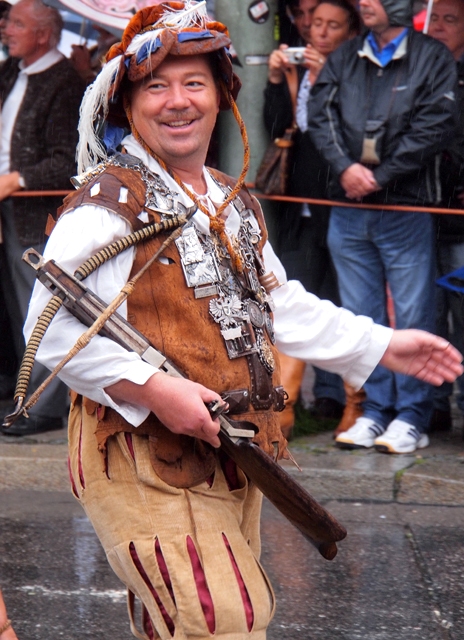
...and crossbows. These were not just hunters, but also Bavarian mercenaries back in the day!
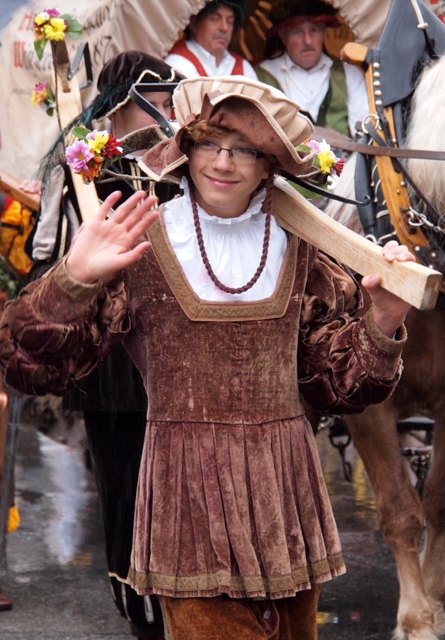
Another outdoor activity was represented: a float the looked like a traditional river raft.
These types of rafts were used since 1300 on the river Kinzig in Baden-Württemberg:
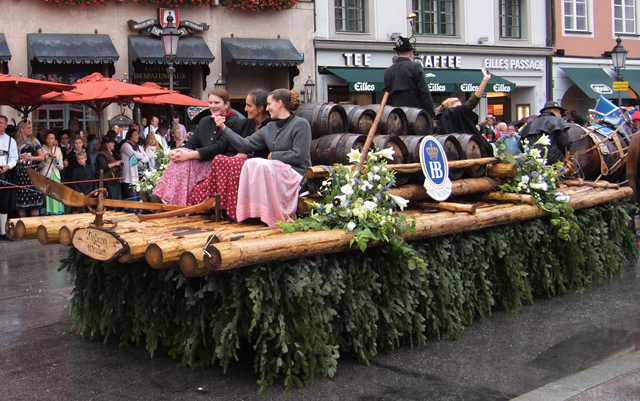
The strangest: traditional "feathering" (colonial activity, ladies separated the feathers for pillows, etc.):
Ladies showed some traditional dress on the horses as well:
Of course, the horses themselves were decked out nicely (note the German beard on the driver too):
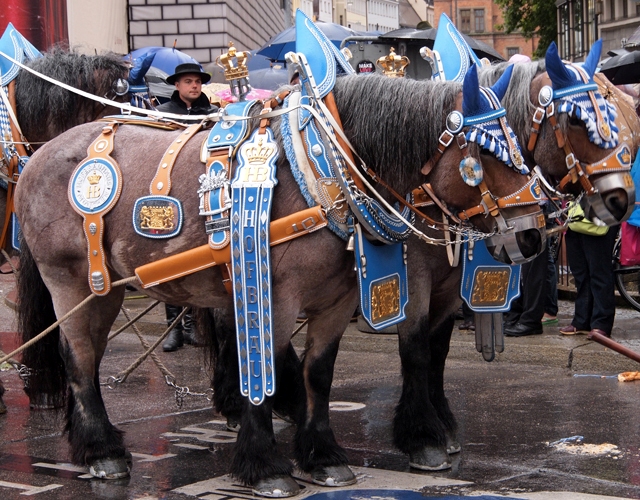
Some carts were not blessed with a big, strong team of horses (LOL):
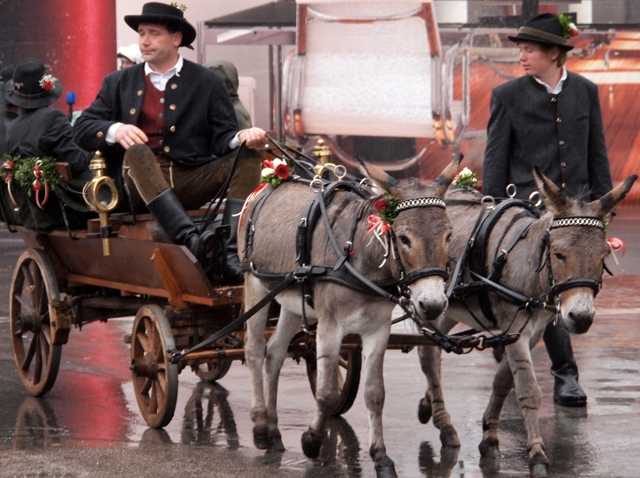
The marching bands also used traditional uniforms:
Some uniforms had great assessories, like this headpiece (represents a halo?).
This marching band comes from the German state of Baden-Württemberg, Bavaria's neighbor:
The bands also used some old fashioned instruments too:
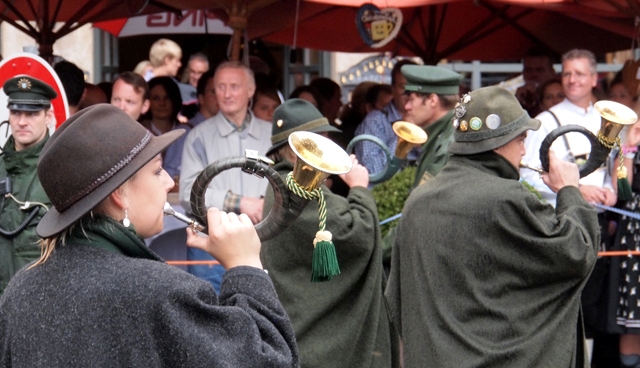
Photos above and below are hunting horns from the Bavarian Hunting Association:
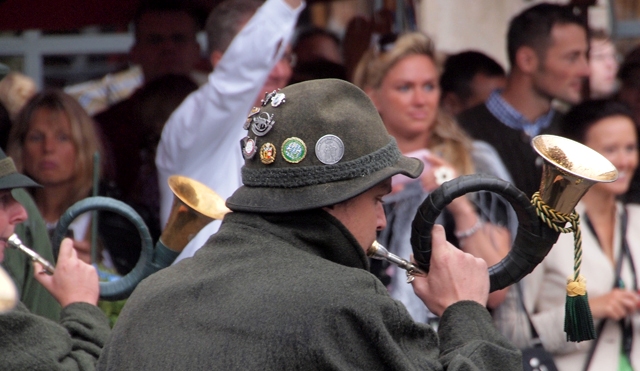
This folk music / marching band with leading ladies came from Folgaria, Italy.
Commercial and non-trachten participants
First things first: there was a weissbier keg cart in this parade, after the first marching band!
The first commercial sponsor of the parade? BMW of course!
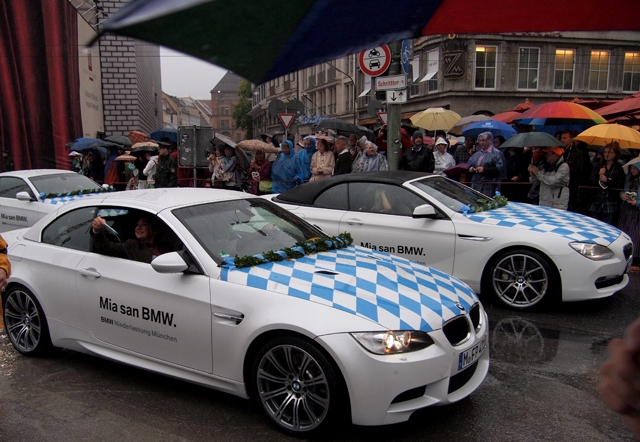
The car rental company Sixt (also a partner with BMW) had an "oom-pah" band playing on their float:
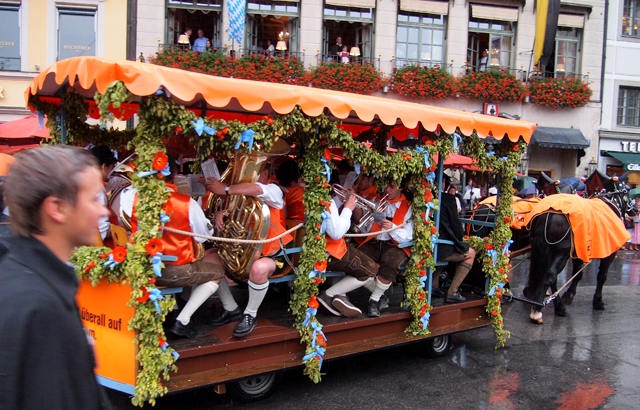
An old-fashioned fire truck drove through...
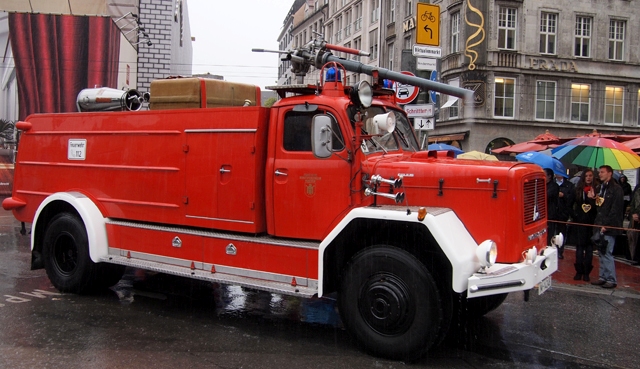
...and a float of firemen in traditional uniforms. The guy in front is not looking happy in the rain.
This was the voluntary Munich Fire Brigade's uniform in 1895.
Bavarian farming was represented too (not surprising), with this large tractor from the company BayWa:
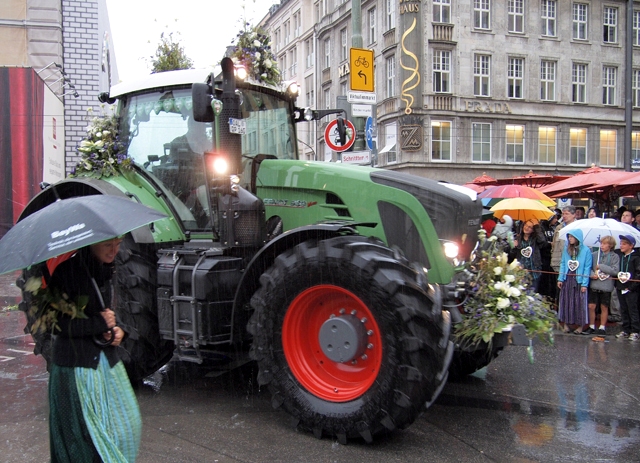
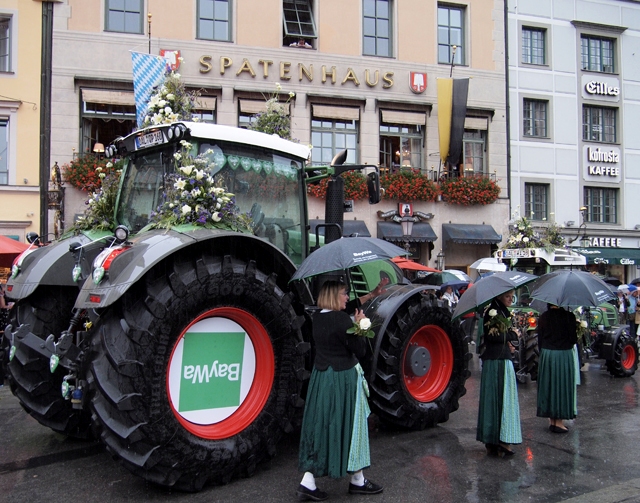
Milk farmers of Bavaria also had a spot. I love the complaining German woman on the left:
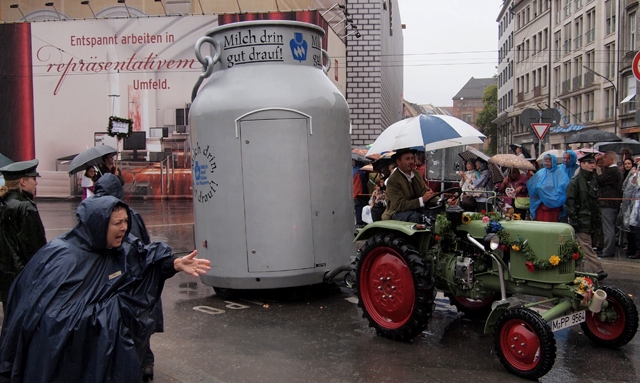
Multi-person bike tours took the advantage to advertise... but the larger beer/party bikes have been banned!
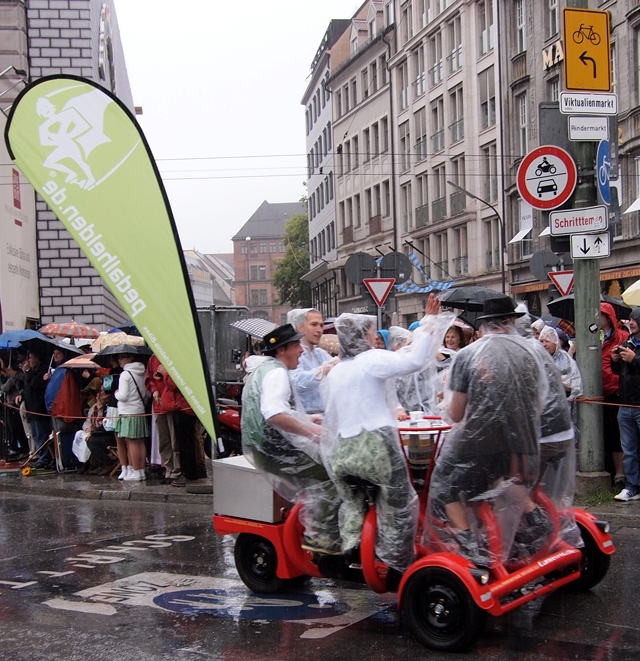
This float had something to do with Russia and Moscow -- they threw pretzels from the stacks to the crowd...
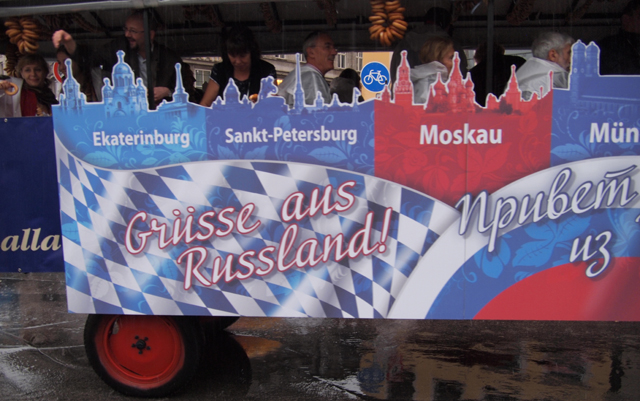
... and I caught one! Even though it never hit the ground, it was damp and soggy. Did not eat it.
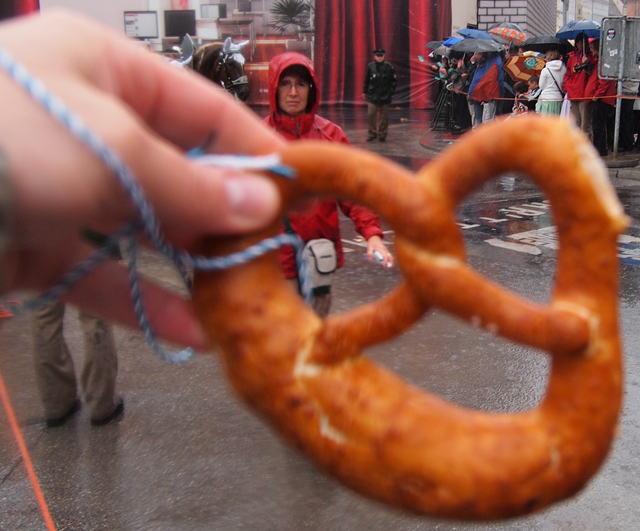
The last photo: a float from Narrhalle reminded everyone that Fasching (Mardi Gras) is just a half year away....
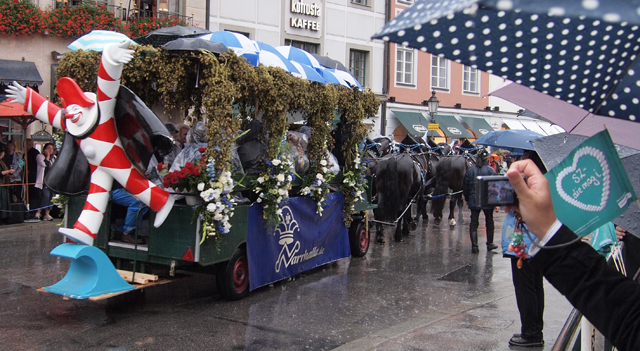
 Herr J ...
Herr J ...  Post a Comment
Post a Comment  Germany & German Culture tagged
Germany & German Culture tagged  Oktoberfest,
Oktoberfest,  parade,
parade,  trachten
trachten  2 References ...
2 References ...  Print Article
Print Article  Email Article
Email Article  Share Article
Share Article  Wednesday, August 31, 2011 at 9:01
Wednesday, August 31, 2011 at 9:01 I have been working on the dirndl in sporadic bursts, but it finally is starting to take shape. I think the top is 80% of the work!!
Both layers of the bodice are complete and I've pinned them together. I need to make a few adjustments but am almost ready to attach the pieces and put on the skirt. So far, so good...
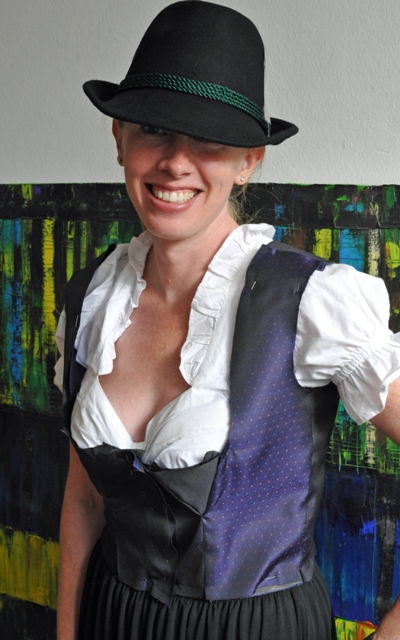
This weekend we stumbled upon a great trachten outlet just outside of Munich and I picked up a fun trachten hat.
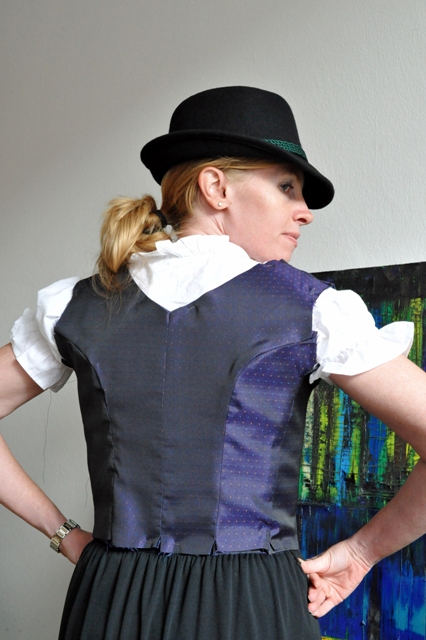
I hope to make some further progress this week, but have a couple of work trips planned.
 Frau A ...
Frau A ...  3 Comments
3 Comments  Fashion, Style, & Shopping tagged
Fashion, Style, & Shopping tagged  DIY (do it yourself),
DIY (do it yourself),  dirndl,
dirndl,  sewing,
sewing,  trachten ...
trachten ...  Print Article
Print Article  Email Article
Email Article  Share Article
Share Article  Thursday, August 11, 2011 at 9:00
Thursday, August 11, 2011 at 9:00 After many, many hours of marking, pinning, and cutting, I'm finally making some progress on the dirndl project.
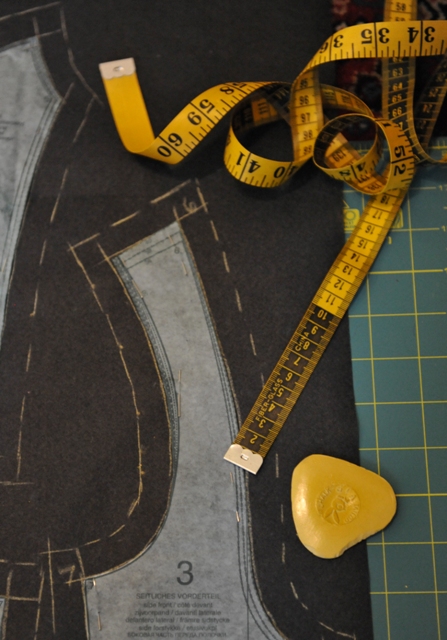
Let's just say that this will be a giant learning experience, as the instructions are full of a long list of things I've never done:
So, to start off, I decided to be cautious and do something else I've never done before - make a test version!
As usual, the first challenge was figuring out what size to use: (For those of you non-sewers, the pattern comes drawn for several sizes and you cut it out to your size). This part is never fun, as your pattern size usually is a size or two (or three) above the size you wear from a store. Similar to how couture and some designers haven't changed their sizing over the years will have you in a larger size than the other designers who have increased the sizing over the years.
The test version worked out ok, though it did show me this would be much harder than I thought!
And then the not so fun part began....I traced and cut and traced and traced and... For the 6 pattern pieces, I had to mark and cut each one 6 different times! And I ended up doing an extra 2 sets because I'd cut out the lining backwards. So, the bright purple cotton lining is now a blue silky patterned fabric. A much better choice, but frustrating to have to do it all over again.
As you see from the top picture, I had to draw 1.5mm seam allowances around everything before cutting it out.
Here we have the outside of the dirndl cut. The skirt parts are cut out too, but I've put those away for now. I think the bodice will be 80% of the work!
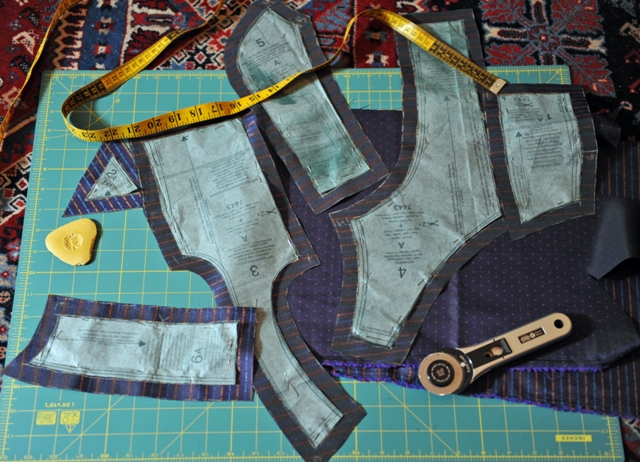
After all that cutting, I decided to cheat a little on the lining. Since all of the markings would be on the interfacing (the black material, which irons onto the lining fabric). I just ironed them on to the lining and then cut around it. I couldn't bear the the process of measuring and drawing the seam allowances again!!
I took advantage of having cut out the lining backward and used those pieces as another test. After my first not-so-good attempt, I researched how to sew curves and princess seams. (excellent hint from ThreadsMagazine: cutting notches in the convex one and ironing out the concave one to make it bigger is a HUGE help).
Not bad for a beginner! (though apparently I need a tailor's ham to properly iron out the curve...yet another thing I knew nothing about)
And everything is laid out to start the sewing (lining, interfacing side up)
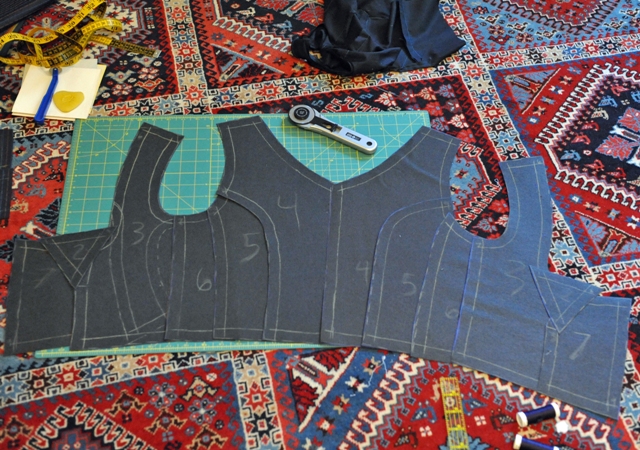
The funny part is that the actual sewing part takes very little time. It's all the measuring, marking, pinning, and cutting that takes all the time. Oh, and the reading the pattern a thousand times to try to understand what it is saying. I swear, it's tougher to decipher than most legal documents!
So here's the first measurable progress, the bodice lining.
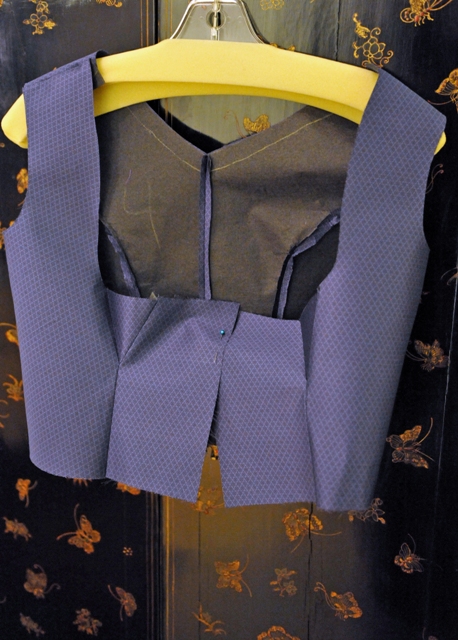
I definitely like this lining better than the first fabric!
Hopefully I'll get some free time to work on the outside this week.
 Just for Fun tagged
Just for Fun tagged  DIY (do it yourself),
DIY (do it yourself),  dirndl,
dirndl,  ok,
ok,  sewing,
sewing,  trachten
trachten  1 Reference ...
1 Reference ...  Print Article
Print Article  Email Article
Email Article  Share Article
Share Article